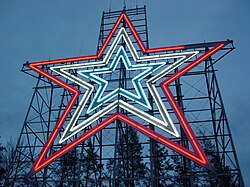Mill Mountain Star
|
Roanoke Star
|
|

Roanoke Star seen at early evening
|
|
| Location | Mill Mountain, Roanoke, Virginia |
|---|---|
| Coordinates | 37°15′3″N 79°55′58″W / 37.25083°N 79.93278°WCoordinates: 37°15′3″N 79°55′58″W / 37.25083°N 79.93278°W |
| Area | 0.5 acres (0.20 ha) |
| Built | 1949 |
| Architect | Roy C. Kinsey; Roanoke Iron and Bridge Works |
| NRHP Reference # | 99001375 |
| VLR # | 128-0352 |
| Significant dates | |
| Added to NRHP | November 15, 1999 |
| Designated VLR | September 15, 1999 |
The Roanoke Star, also known as the Mill Mountain Star, is the world's largest freestanding illuminated man-made star, constructed in 1949 at the top of Mill Mountain in Roanoke, Virginia. After construction of the star, Roanoke was nicknamed "Star City of the South". It is visible for 60 miles (97 km) from the air and it sits 1,045 feet (319 m) above the city of Roanoke.
In 1949, the Roanoke Merchants Association decided to kick off that year's Christmas shopping season by having a neon star built on top of Mill Mountain. Although the structure was always intended to be a permanent addition, the merchants at first weren't sure if the star should be lit year round. When the star immediately became very popular, the Chamber of Commerce and the Merchants Association decided to keep it lit all year. The Merchants Association is credited with the construction of the star, but no single person claimed credit.
Initially, the star was illuminated in all-white. Later, the star's color would change from white to red to indicate a traffic fatality on that day. As part of the bicentennial celebration in 1976, the design was changed to an outer single star of red encompassing inner double-stars of white and blue. Generally all the colors have been lit at once, but occasionally the colors have been lit in a repeating sequence: each color shows exclusively for a second or two, or in succession. To commemorate a tragic event, the red outer star has been used alone, in a manner akin to a lowered flag. Such commemorations have been made for national and local events. After the September 11, 2001 attacks, the star was kept in a red, white, and blue configuration for nearly six years, until April 2007.
On August 12, 2006, the star was turned off for eight days for the city to perform significant electrical upgrades. Outdated junction boxes, transformers, wiring, and conduits were replaced. Many of these devices are from the star's original 1949 construction. The upgrades cost $100,000. The work is expected to save the city more money in the long run due to a reduced need for maintenance.
On April 17, 2007, the star had to be turned off because one of the power lines had been heavily damaged by a tree. When the star was relit on April 22, 2007, officials changed the color configuration to all-white "as a symbol of hope" after the Virginia Tech massacre.
Red, white and blue colors were restored May 24, 2007 and remained that way until returning to all white on September 12, 2011.
The Mill Mountain Star is 88.5 feet (27.0 m) feet tall with 2,000 feet of neon tubing. It requires 17,500 watts of power to illuminate the neon tubes, so it puts out a pleasant little hum. Roy C. Kinsey of Kinsey Sign Company built the neon tubes with his three sons Roy Jr., Bob, and Warren. It was assembled near a local airplane hangar to study how it looked. Then it was driven to the top of the mountain and placed onto a steel structure. Robert L. Little was the Structural Engineer for Roanoke Iron & Bridge Works at the time and helped on the project as well.
...
Wikipedia


